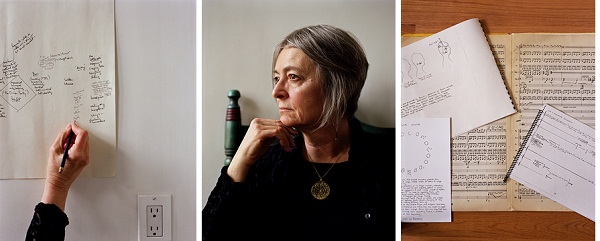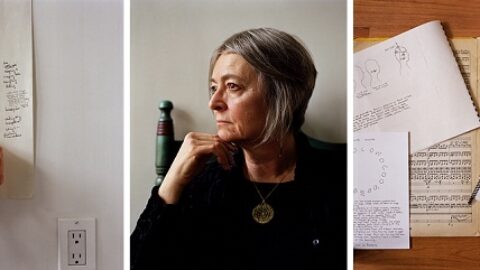This weekend’s Ne(xt)works’ Music Without Dance—a multi-event festival focusing on recent and historical musical works originally created to be heard with choreographed movement—was the perfect excuse to interview Joan La Barbara and talk about dance, as well as Phase Two of Storefront Diva…
Your name is usually associated with a life-long relationship with voice but you have also written extensively for dance. What led you to do so?
I love dance. In fact, as a child I wanted to be a dancer but my mother read an article about ballerina’s bloody toes and decided not to let me study dance. She gave me piano and art lessons instead.
Anyway, I have watched a great deal of dance over the years and have been particularly influenced by Merce Cunningham’s independent moving of dancers in space (which I reflected in my work “Autumn Signal” as I moved the sounds around in space), and also his attitude that whichever way the dancers were facing was front (again, reflected in some of my sound sculpture works). I was very, very fortunate in 1976 to be invited to play my music with Merce in an Events evening. Ned Rothernberg and Peter Zummo were working with me at the time and we did several of my ensemble works as well as some of the solo material. The way the “Events” worked was that Merce told the composer how much time to provide music for, and he allocated sections of his dances to fit that time. I remember that just as I began to sing “Circular Song”, Merce began a solo, edging forward carefully one foot at a time, then pulling it back and making sudden gesture flurries with his hands. It was thrilling.

My recorded music has been used, with permission, by many choreographers and I have been privileged to collaborate on new works, in recent years and on several occasions, with two marvelous choreographers, Nai-Ni Chen and Jane Comfort, who work very differently. Nai-Ni first contacted me to use one of my recorded compositions for her work “Du”. Later, her dance company commissioned me to do a new work for voice and chinese instruments based on a series Nai-Ni was involved with, on aspects of calligraphy. I was very happy to be able to work with chinese musicians, learning the idiosyncrasies of their respective instruments as they learned my notation which included graphics as well as traditional western notation. In another work, I approached Nai-Ni about working with her dancers’ voices and she enthusiastically embraced that concept. The dancers, although very willing, had some difficulty releasing the breath and air into their movement. I learned that many dancers hold their breath while they are executing movements and the release when they are finished. So my idea of sound flowing through movement was more difficult to achieve than I had anticipated. Nai-Ni often worked with the natural elements of earth,air,wind and fire and sometimes incorporated elements of martial arts into her movement concepts.
In working with Jane Comfort, the fact that the dancers used their voices was a given (that is part of what Jane does). So engaging the dancers in vocal activities was not a problem. In the first work we did together Jane utilized aspects of some of my existing works as well as developing new works for the dancers. In the second, Jane and I agreed to deal with the politically charged topic of “rendition” and so I spent many hours working with the dancers on aspects of theater and releasing themselves into a “character” or “persona” which had nothing to do with their own personal beliefs.
A question about your creative process: do you approach writing for dance in a different way?
I engage the choreographers that I work with in dialog to establish how we will collaborate. Each of the choreographers works in a unique way and we agreed on a process so that we could move forward with the development of the pieces. In some cases, the movement came first and I created music that felt appropriate to me. In other cases, I sent samples of my sonic ideas, and the choreographers would then create movement reflecting the energy and shape of my music. In other circumstances, we would sit and discuss concepts, the go back to our studios and create work and then put them up simultaneously, often to striking and astounding results.
Writing for dance is much like writing for film in that you are in a collaborative situation and there is a degree of give-and-take, depending on who is in the driver’s seat.
You are also a very active educator; do you encourage your students to write for dance? What is there for them to gain from writing for dance?
I always encourage my students to explore the various avenues in which they may explore their creativity in sound, whether it be in concert music, with film or video, with movement or installation works. I want to open the entire range of possibilities for them and want them to think about music as a means to explore their own creative potential.
This coming Sunday, as part of Ne(x)tworks’ Music without Dance Festival, you will join a panel discussion on the relationship between music and dance. Are you satisfied with the state of things between these two art forms?
That is a difficult question to answer. There are many collaborations between choreographers and composers that have marvelous results; there are many that seem as if someone has pasted the collaborators together for reasons other than art and it is clear that very little dialogue and communication took place. There is a marvelous program that was initiated by the American Music Center called Live Music for Dance which has encouraged dance companies to engage with composers and musicians to bring live music back to the aspect of dance. For many years, dance companies relied on recorded music and the energy and life force of dealing with live music cannot be underestimated. I remember that I created a recorded example of my music for one of Nai-Ni’s dances, just to give them something to relate to, and then when we got together to rehearse, the dancers were dumbfounded that the music was not absolutely identical to the recorded example. It took a few rehearsals, but we managed to work through the issues that the dancers had and I began to incorporate the sonic cues that the dancers needed for certain movements.
Back in December, we featured Storefront Diva (Phase One) in our music video series. Can you tell us more about Phase Two?
Phase One of Storefront Diva involved the incredible pianist Kathleen Supové playing fragments of my music interspersed with the Debussy Prelude #6, as if she were practicing in her home. I wanted the audience to peer into this precious situation, being offered a window into a private world, and also exploring aspects of the voyeur in all of us. In Phase Two, I will compose a fully notated composition that Kathleen plays while aspects of the prior “Storefront” performance are projected on her and on the piano, allowing past and present, dream and waking states to co-exist. Phase One was in a rented “pop-up” store on Bleecker Street. Phase Two will be in Flea Theater (June 2012) in a more conventional environment but with fragments of the set created for Phase One, as memory, dream, alternate reality.
Joan La Barbara wanted to share a video with our readers:
For more information about Ne(x)tworks, Dance without Music Festival, visit: http://www.greenwichhouse.org
Joan La Barbara: http://www.joanlabarbara.com
























